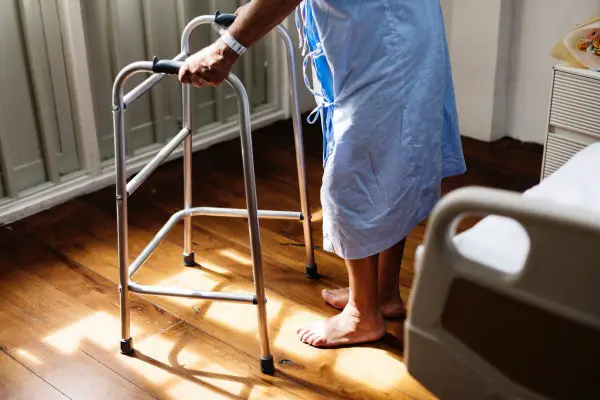Debbie Middleton’s lower left leg started swelling up. So, she was sent to a vein specialist. Turns out, she had varicose veins. A leaky vein in her leg needed to be closed off.
There were a couple of treatment options for her to consider. She chose a newer, safer procedure using Medtronic’s VenaSeal™ Closure System, a newer FDA-approved superglue substance that closes the main vein in the leg causing varicose veins. Simple enough.
But, for Debbie, this is where the story takes a dramatic turn.
While the superglue was supposed to help stifle the varicose veins, Debbie was having a very peculiar reaction to it. The area in her lower leg that had been treated was bright red. It was hot. It didn’t look or feel right.
She tells the story across Facebook. She shares pictures. Warning: the pictures in this post are graphic.
According to her Facebook post, after “multiple appointments over months in severe pain, swelling and daily ibuprofen (recently diagnosed as stomach ulcers through endoscopy),” she was finally able to convince her doctor there was something significantly wrong with her leg. “At this point, my leg was much worse than it was prior to having it close off with [VenaSeal™].”
After 10 months, Debbie’s vascular specialist agreed to do a patch test on her back to determine if she was allergic to VenaSeal™.
According to Debbie’s post, her “back lit up on fire where the glue had been applied.”
There was no mistaking it: Her body was having an allergic reaction to the vein superglue and was fighting this foreign body.
The initial solution was to perform surgery on her leg to quell the situation. A vascular surgeon went in to strip an 18 inch vein from her upper to lower leg.
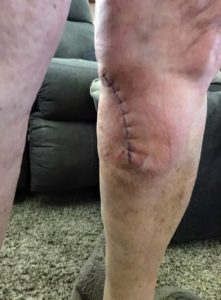
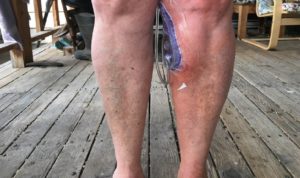
Debbie writes on Facebook: “I feared my lower leg would have issues with glue particles since it wasn’t able to be removed as one whole piece like my upper vein in a stripped fashion. Immediately a 1 inch section of my incision wasn’t healing like the rest of the 4.5 inch incision. There seemed to be something festering in two areas that bulged! I was able to extract 2 slivers of glue that came to a head in my incision.”
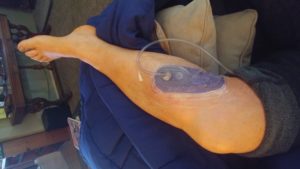
She went back to the doctor who performed the surgery “who determined we would need to remove a huge chunk of tissue as our best attempt to get remaining glue out. He felt this was aggressive and thought we should attempt removing glue in his office from the surface. It was confirmed through pathology there was more glue in my leg.”
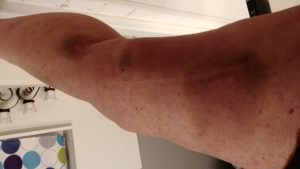
On June 18, 2018, she had her second surgery to attempt to remove the glue. She writes that the “plan was to remove 4 inches long by 1 inch and deep to be sure all glue was removed once and for all. As I sit here recovering from a (hot dog bun size) 6 plus inch incision, more than an inch wide with more flesh removed internally to the bone, I am certain what was found was not good! I am waiting for my follow up appointment and pathology reports from this procedure.”
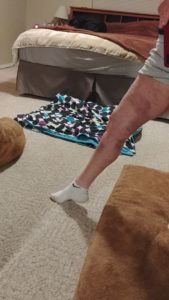
There are only a small handful of cases worldwide where someone had a serious allergic reaction to it. One medical expert noted that this would likely never happen again in the entire state of Oregon, where Debbie lives.
Debbie does not blame the vascular specialists who worked with her. She writes that she feels the industry pushed this product on doctors.
It appears there may be lifelong complications she’s facing from using this product. She’s advocating for a pre-operative test to determine if people are allergic to the glue.
But according to allergists, exposing people to the seal before an operation can actually increase the odds of a reaction. Moreover, there is a concern about false positives, which means some people who could stand to benefit from the ease of the VenaSeal™ Closure System would be prematurely shut off from it.
According to current data, the likelihood of having some kind of serious reaction to VenaSeal™ is around 1 in 10,000. To put that into perspective, you have a three times greater chance of being struck by lightning in your lifetime.
Last year, Medtronic touted long-term data from VenaSeal™ studies that showed the “long-term benefits and quality of life” for patients treated with it.
The Ultimate Vein Guide reached out for an official comment from Debbie to discuss her posts shared in a number of places on Facebook. She wrote back that she is “unable to discuss specifics of my case at this time. I’m working with Medtronic directly regarding my severe allergic reaction to the glue.”
*Disclaimer: “We are a participant in the Amazon Services LLC Associates Program, an affiliate advertising program designed to provide a means for us to earn fees by linking to Amazon.com and affiliated sites.”
Read This Next
Varithena is a minimally invasive procedure designed to treat varicose veins by using prescription medicine injected in the form of a microfoam to close off a non-functioning...
Read MoreInvasive varicose veins surgery is often considered a last resort for treating severely damaged veins; fortunately there are many types of varicose veins surgery, ranging...
Read MoreUltrasound guided sclerotherapy, or UGS, is a specialized procedure designed to treat and eliminate branch varicose veins located at or just below, the surface of the skin. ...
Read MoreDebbie Middleton’s lower left leg started swelling up. So, she was sent to a vein specialist. Turns out, she had varicose veins. A leaky vein in her leg needed to be closed...
Read More





